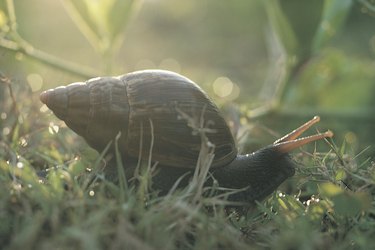
Snails are voracious eaters and cause considerable damage to garden plants, particularly succulents, tender young shoots and flowers. Because most snails are nocturnal and hide during the daylight hours, they can be difficult to spot and remove by hand. To verify that snails are causing damage in your garden as opposed to other pests, look for an unattractive, slimy trail. Natural snail control methods will eliminate the bothersome creatures without harming beneficial insects and wildlife or damaging the ecosystem. All snail control methods will also control slugs.
Yard Maintenance
Video of the Day
Remove overturned pots, cedar blocks, logs and similar items that snails use as hiding spots during the day. Snails like to hide in moist, dark areas. Without acceptable hiding spots, snails will migrate elsewhere to avoid heat and sun.
Video of the Day
Hand Picking
Look for snails on cool, moist days when they are most likely to be out in the daylight, or search for them underneath hiding places. Remove any snails you see and dispose of them by crushing them, throwing them in a garbage bag, transporting them to a location away from your garden or placing them in a bucket of soapy water. If you kill the snails, you can add them to your compost pile.
Barriers
Commercial garden mulch or a mulch made from crushed eggshells or seaweed repel snails, who dislike getting their foot dirty. Eggshell and seaweed mulch are beneficial in supplying nutrients to garden plants. Pile mulch to a 3-inch depth around all plants you wish to protect.
Melon Rind Traps
Overturned melon rinds provide moist, dark hiding spots for snails. Place the rinds around the garden and turn them over during the day to reveal hiding snails. Dispose of the snails using the method of your choice.
Predators
Introducing domesticated ducks, geese and chickens to target areas in your garden can control a moderate snail problem. These birds may also eat seedlings, however.